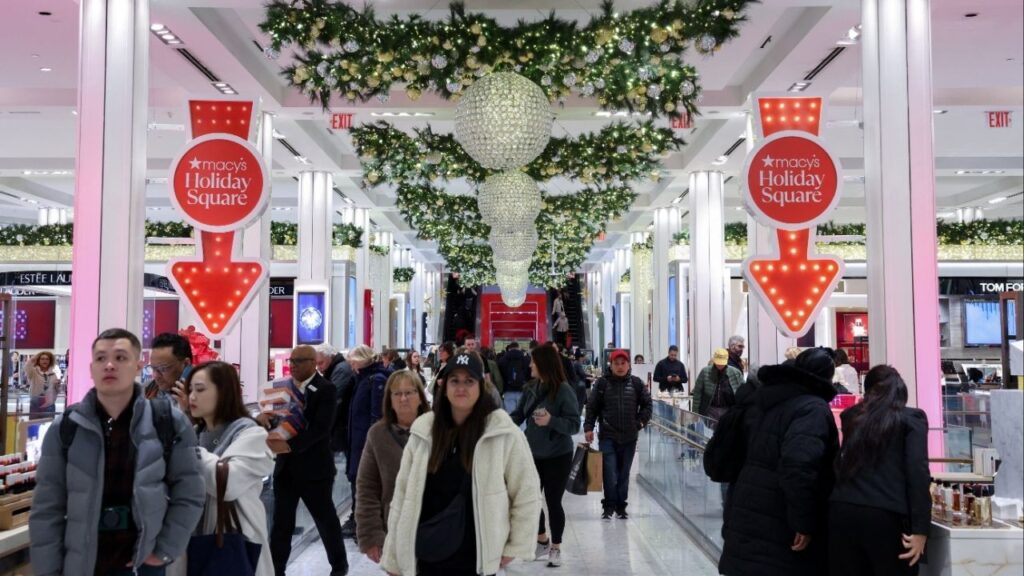Retail sales inch up 0.1% in August, signaling consumer resilience amid economic challenges and Fed's rate cut considerations. (AP/David Zalubowski)

- Consumers continue spending despite inflation and high interest rates, with online retailers and home goods stores seeing sales growth.
- Federal Reserve considers interest rate cuts, potentially boosting economy and lowering borrowing costs for mortgages and credit cards.
- Shoppers adapt to economic pressures by seeking deals and discounts, with major retailers planning promotions for the holiday season.
Share
|
Getting your Trinity Audio player ready...
|
WASHINGTON — Americans spent a bit more at retailers last month, providing a small boost to the economy just as the Federal Reserve considers how much to cut its key interest rate.
Retail sales ticked up 0.1% from July to August, after jumping the most in a year and a half the previous month, the Commerce Department said Tuesday. Online retailers, sporting goods stores, and home and garden stores all reported higher sales.
Consumers Show Resilience Despite Economic Challenges
The data indicate that consumers are still able and willing to spend more despite the cumulative impact of three years of excess inflation and the higher interest rates intended to combat those rising prices. Average paychecks, particularly for lower-income Americans, have also risen sharply since the pandemic, which has allowed many Americans to continue spending even as many necessities became more expensive. And price increases are slowing, with inflation falling to a three-year low last month of 2.5%.
The impact of inflation and consumers’ health has been an ongoing issue in the presidential campaign, with former President Donald Trump blaming the Biden-Harris administration for the post-pandemic jump in prices. Vice President Kamala Harris has, in turn, charged that Trump’s claim that he will slap 10% to 20% tariffs on all imports would amount to a “Trump tax” that will raise prices further.
Related Story: US Inflation Reaches a 3-Year Low as Federal Reserve Prepares to Cut Interest ...
Economic Growth Remains Solid Despite Concerns
A slowdown in hiring and a recent rise in the unemployment rate have fueled concerns the economy is sputtering, yet steady spending should boost growth. The Federal Reserve’s Atlanta branch estimates that the economy grew at a solid 2.5% annual rate in the third quarter.
“With consumption still very healthy, for now, recession fears appear overblown,” Olivia Cross, North America economist at Capital Economics, said.
The Fed could provide a further boost to consumers and the economy by lowering borrowing costs. It is likely to reduce its key rate at its meetings in November and December as well as on Wednesday. Such cuts should, over time, lower rates for mortgages, auto loans, and credit cards. Average mortgage rates have already fallen in anticipation of the Fed’s actions.
Related Story: Stock Market Today: Wall Street Rises as Market Focus Turns From Nvidia to the ...
Consumers Adapt to Economic Pressures
Consumers have been showing signs of stress, with credit-card debt rising and savings rates falling, trends that could weigh on spending in future months.
Kamie Meeks, a 22-year-old college student in New York City, said that inflation has made her better at finding lower priced goods. She does her food shopping at the discounter Aldi. She shops mostly online at Walmart and at Chinese retailers like Shein and Temu.
It’s easier to “find deals” online, Meeks said.
In August, sales jumped 1.4% for online retailers in August and rose 0.7% at health and personal care outlets. Yet they were flat for restaurants and bars, a sign that consumers are holding back from some discretionary spending.
Gas stations reported a 1.2% drop in sales, which mostly reflected a decline in prices last month. Auto sales also ticked lower.
Related Story: US Consumer Confidence Rises in August as Americans’ Optimism About ...
Federal Reserve Considers Interest Rate Cuts
On Wednesday, Fed policymakers will decide whether to cut their key interest rate by a typical quarter-point or a larger-than-usual half-point, from its current level of about 5.3%, a 23-year high.
Wall Street is increasingly expecting a reduction of a half-point. With inflation headed back to the Fed’s 2% target, many economists also argue that the central bank does not need to keep rates that high. At the same time, some Fed policymakers who worry that inflation could remain stuck at its current level of 2.5% may not want to cut rates that fast. They could point to solid retail sales as evidence that there is no need to rush rate cuts.
One reason inflation has fallen from a four-decade high of 9.1% in June 2022 has been consumers’ reluctance to pay some of the higher prices they’ve encountered at grocery stores, restaurants, and clothing stores. Instead, shoppers have traded down to store brands, sought out deals or spent more at discount retailers. Some packaged food makers, fast-food restaurants, and retailers such as Target have responded by cutting prices or offering deals to entice shoppers.
Major retailers say that shoppers will likely remain cautious heading into the critical holiday season, so they’ll be pushing discounts.
“Overall, customers remained deal-focused and attracted to more-predictable sales moments with 4th of July, Black Friday in July and the beginning of back-to-school sales events,” Best Buy’s CEO Corie Barry said recently.
RELATED TOPICS:
Categories

Trump Strategy Document Revives Monroe Doctrine, Slams Europe


















